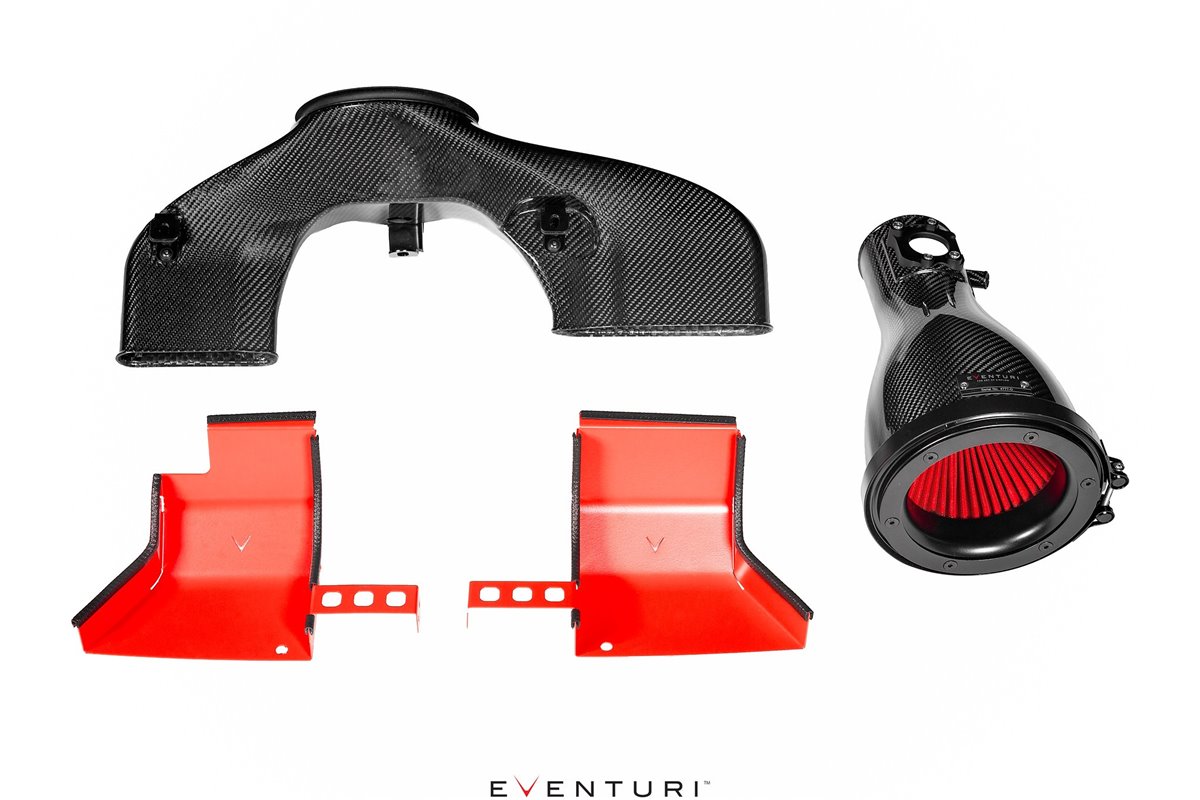- -10%


Performance increase: 10-14 hp, 10-11 ft. per pound
*The images show our engine cover in optional carbon.
The GR86 Eventuri system uses our patented carbon fiber housing that provides an aerodynamically efficient airflow path from the filter to the engine. Not just another conical filter with a heat shield, but a unique design that mimics the Venturi effect and maintains optimum laminar flow to reduce drag on the engine.
![]()
![]()
![]()
![]()
![]()
![]()
![]()
![]()
![]()
![]()
![]()
![]()
![]()
![]()
The GR86 intake is the result of extensive configuration testing with over 125 dynamometer runs to arrive at an optimised design. We tested both stock and tuned cars to assess the impact of modifying the intake to a less restrictive version. The 2.4 litre NA Boxer engine is sensitive to intake air temperatures, so our initial priority was to ensure a fully sealed system. Dynamometer testing revealed a power drop around 6000 rpm on the stock ECU. This drop persists regardless of intake configuration: even with all possible restrictions removed, a higher flow intake creates strong engine resonance at this rpm, causing a momentary drop below the stock curve. The stock airbox has a disconcerting effect at this rpm, but then also limits top end power. By iterating our design through testing different intake lengths, single and dual duct ports, and even adding baffles, we arrived at a version that minimizes resonance drop, gaining 14 top end horsepower over the stock ECU. Once the ECU is set up, we can observe significant gains in the mid-range and the elimination of the power drop below the stock curve.
Testing on the test bench - STOCK ECU
Below is a dyno plot of a completely stock GR86 with only the airbox replaced with the Eventuri intake. This was independently tested at DREAM Automotive. Several runs were performed with the OEM airbox to get a repeatable result and then again with the Eventuri intake. The tests were performed on the same day back to back. The results show an increase in peak torque and power with a "resonance" drop between 5700-6300 rpm after which the power increase amounts to 14 hp as the curve crosses the stock line and continues up to the rpm limit.
Dyno Testing - ECU TUNING
Below is a dyno plot of a GR86 that has been custom tuned by Paragon Performance in the USA. They tuned the car to run on E85 with a closed loop fuel control to ensure fueling is identical on both the stock intake and the Eventuri to remove the variability of the GR86's open loop fuel control. Paragon also tuned the ECU to eliminate the resonance issue and the results speak for themselves. All runs were run with the same tune and only the airbox was changed between runs. The tests were performed on the same day consecutively.
The Eventuri GR86 intake system is made up of a series of components designed to perform a specific purpose and manufactured to the highest standards. We use 100% pre-preg carbon fibre with no fibreglass, which means we can achieve a smooth internal surface to maintain a smoother airflow. Here are the details for each component and the design ethic behind them:
Each intake system consists of:
FILTER HOUSING ASSEMBLY
The filter housing consists of our custom-built 2nd generation filter, aluminum inlet bonnet and integrated MAF section. The carbon pod wraps around the reverse mounted filter and smoothly shapes the airflow into the MAF section which then connects to the rear inlet pipe. This changes the flow path from the OEM airbox where the airflow enters the front of the airbox, changes direction 90 degrees to pass through the panel filter and then changes direction 90 degrees again to pass through the MAF section. Our system is much more direct with the airflow entering the front of the filter housing and moving into the MAF section without any abrupt changes in direction. The result is a smoother path from the filter to the turbo inlet pipe and therefore the turbo is able to operate with less drag. To ensure a reliable seal with the MAF sensor, we use a CNC machined bracket that is attached to the carbon housing.
PATENTED TECHNOLOGY
Our patented filter housing features a uniform reduction in cross-sectional area as it wraps around the filter and tapers towards the tube. This geometry is reminiscent of the Venturi effect where the airflow accelerates whilst maintaining laminar conditions. It can be thought of as a large velocity stack - below is a diagram showing how our patented design compares to a typical intake system. Our custom filters assist the airflow as it moves through the housings and allow for a uniform velocity profile as the airflow exits the housings. Further details can be found on the Technology and Filters pages.
CARBON DUCT
The duct feeds the filter housing with ambient airflow from the front bumper/grille section. After testing several iterations, we found that a dual intake where cold air was taken from both openings in the end panel area worked the least restrictive. The region in the front bumper area is saturated with cold air from our scoops and also from the natural design of the OEM cavity behind the bumper. The duct has an expanding rubber gasket that mates to the filter housing to ensure that hot engine bay air is kept away from the intake feed, but still allows for engine movement. It is mounted in 3 positions to ensure a secure fit.
FRONT AIR INTAKES
The final components are 2 front vents that sit behind the lower grille to direct ambient air up into the duct opening. This helps keep IATs low while the car is in motion. For owners with aftermarket oil coolers that cannot utilize the vents, IATs will still remain minimal due to the natural saturation of cold air behind the bumper.